University Assignment: Transportation and Low Carbon Innovation Report
VerifiedAdded on 2022/09/09
|16
|3349
|11
Report
AI Summary
This report investigates the challenges of climate change within the UK's transportation sector, proposing regulatory frameworks and policies for mitigation. It explores disruptive, incremental, and game-changing innovations, offering a management report that suggests solutions to business challenges arising from climate change. The report identifies early adopters of innovative products and services, evaluating how innovation can effectively reduce greenhouse gas emissions. It covers the impacts of climate change on roadways, vehicles, rail, air travel, and ports, highlighting the need for policies that support sustainable urban development and transport. The study summarizes disruptive innovations like Intelligent Transport Systems, public transport planning, connected and autonomous vehicles, and drones for monitoring. It emphasizes the importance of targeting early adopters and leveraging their insights to drive adoption and reduce emissions in various areas such as socio-economics, climate change, and transport efficiency. The report concludes by emphasizing the role of smart mobility, AVs, drones, and ITS as key areas for innovation and leveraging digital technologies to reduce emissions.
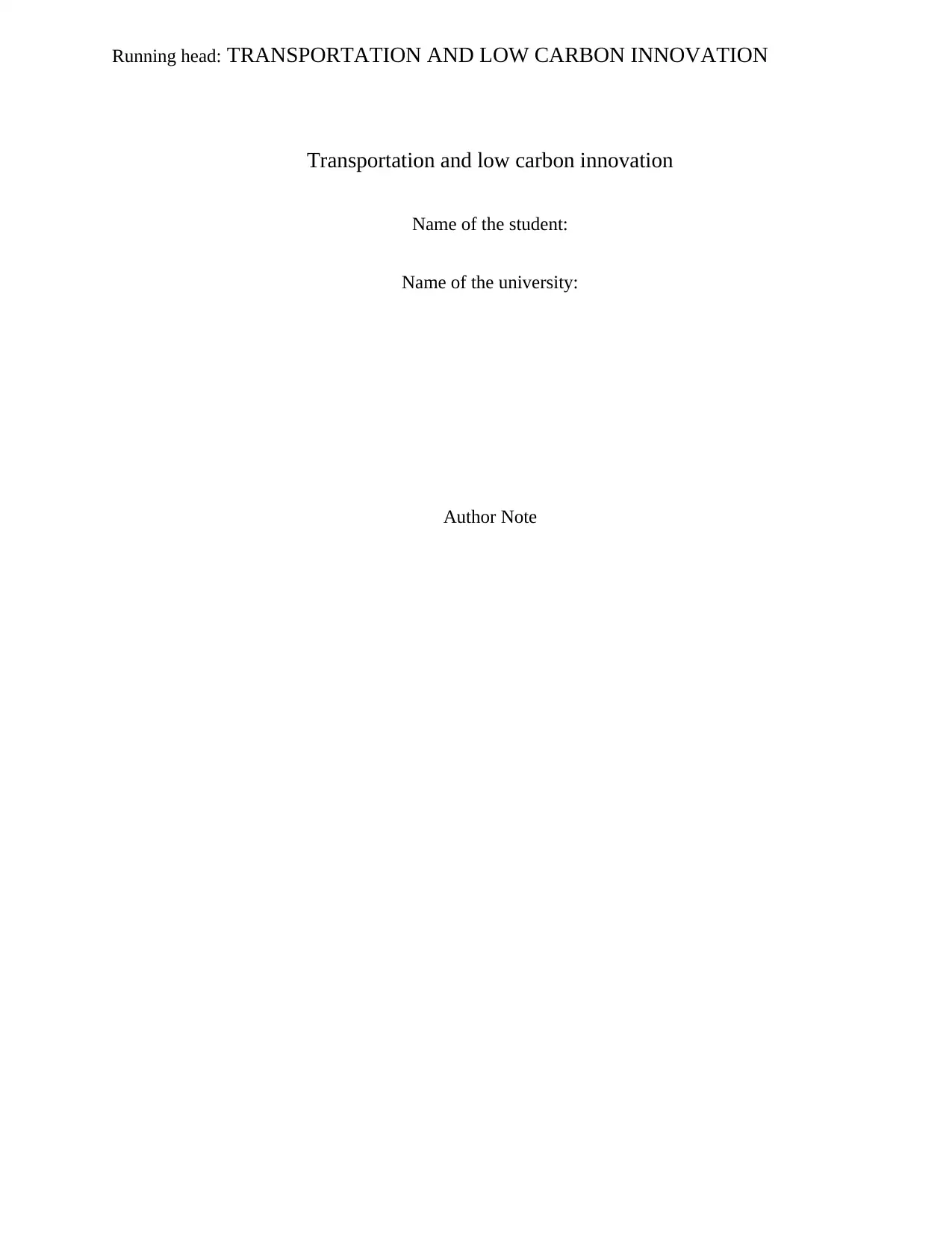
Running head: TRANSPORTATION AND LOW CARBON INNOVATION
Transportation and low carbon innovation
Name of the student:
Name of the university:
Author Note
Transportation and low carbon innovation
Name of the student:
Name of the university:
Author Note
Paraphrase This Document
Need a fresh take? Get an instant paraphrase of this document with our AI Paraphraser
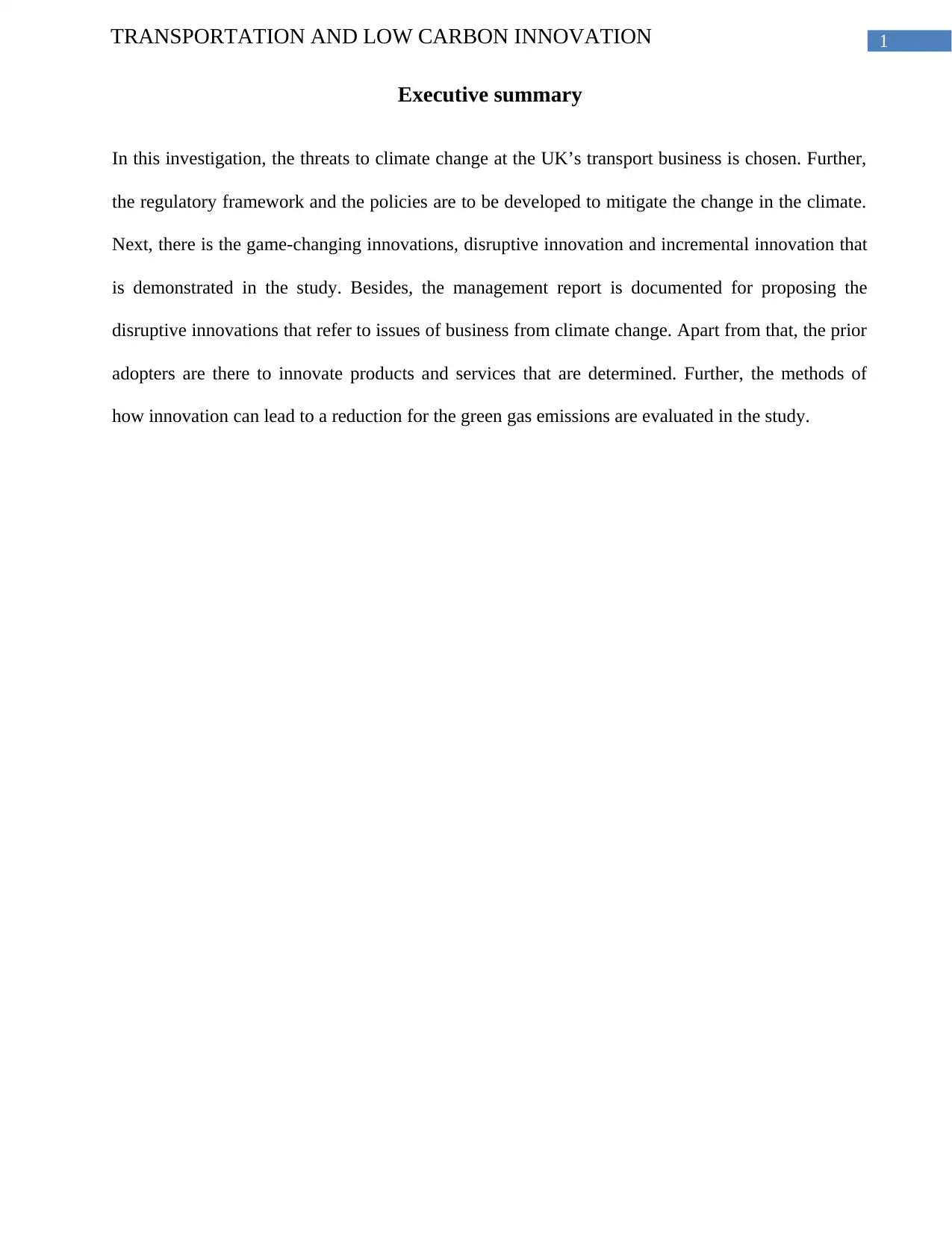
1TRANSPORTATION AND LOW CARBON INNOVATION
Executive summary
In this investigation, the threats to climate change at the UK’s transport business is chosen. Further,
the regulatory framework and the policies are to be developed to mitigate the change in the climate.
Next, there is the game-changing innovations, disruptive innovation and incremental innovation that
is demonstrated in the study. Besides, the management report is documented for proposing the
disruptive innovations that refer to issues of business from climate change. Apart from that, the prior
adopters are there to innovate products and services that are determined. Further, the methods of
how innovation can lead to a reduction for the green gas emissions are evaluated in the study.
Executive summary
In this investigation, the threats to climate change at the UK’s transport business is chosen. Further,
the regulatory framework and the policies are to be developed to mitigate the change in the climate.
Next, there is the game-changing innovations, disruptive innovation and incremental innovation that
is demonstrated in the study. Besides, the management report is documented for proposing the
disruptive innovations that refer to issues of business from climate change. Apart from that, the prior
adopters are there to innovate products and services that are determined. Further, the methods of
how innovation can lead to a reduction for the green gas emissions are evaluated in the study.
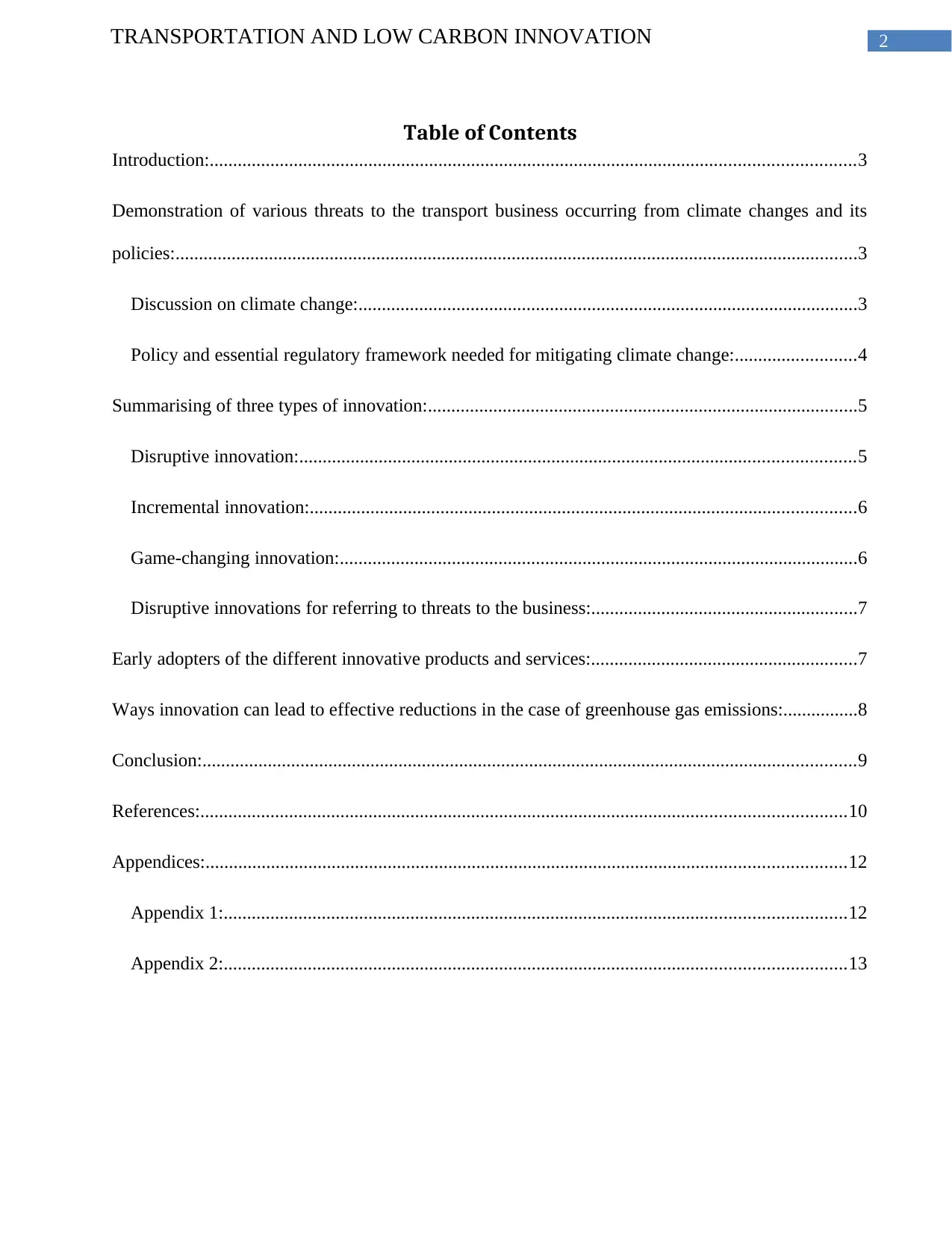
2TRANSPORTATION AND LOW CARBON INNOVATION
Table of Contents
Introduction:..........................................................................................................................................3
Demonstration of various threats to the transport business occurring from climate changes and its
policies:..................................................................................................................................................3
Discussion on climate change:...........................................................................................................3
Policy and essential regulatory framework needed for mitigating climate change:..........................4
Summarising of three types of innovation:............................................................................................5
Disruptive innovation:.......................................................................................................................5
Incremental innovation:.....................................................................................................................6
Game-changing innovation:...............................................................................................................6
Disruptive innovations for referring to threats to the business:.........................................................7
Early adopters of the different innovative products and services:.........................................................7
Ways innovation can lead to effective reductions in the case of greenhouse gas emissions:................8
Conclusion:............................................................................................................................................9
References:..........................................................................................................................................10
Appendices:.........................................................................................................................................12
Appendix 1:.....................................................................................................................................12
Appendix 2:.....................................................................................................................................13
Table of Contents
Introduction:..........................................................................................................................................3
Demonstration of various threats to the transport business occurring from climate changes and its
policies:..................................................................................................................................................3
Discussion on climate change:...........................................................................................................3
Policy and essential regulatory framework needed for mitigating climate change:..........................4
Summarising of three types of innovation:............................................................................................5
Disruptive innovation:.......................................................................................................................5
Incremental innovation:.....................................................................................................................6
Game-changing innovation:...............................................................................................................6
Disruptive innovations for referring to threats to the business:.........................................................7
Early adopters of the different innovative products and services:.........................................................7
Ways innovation can lead to effective reductions in the case of greenhouse gas emissions:................8
Conclusion:............................................................................................................................................9
References:..........................................................................................................................................10
Appendices:.........................................................................................................................................12
Appendix 1:.....................................................................................................................................12
Appendix 2:.....................................................................................................................................13
⊘ This is a preview!⊘
Do you want full access?
Subscribe today to unlock all pages.

Trusted by 1+ million students worldwide
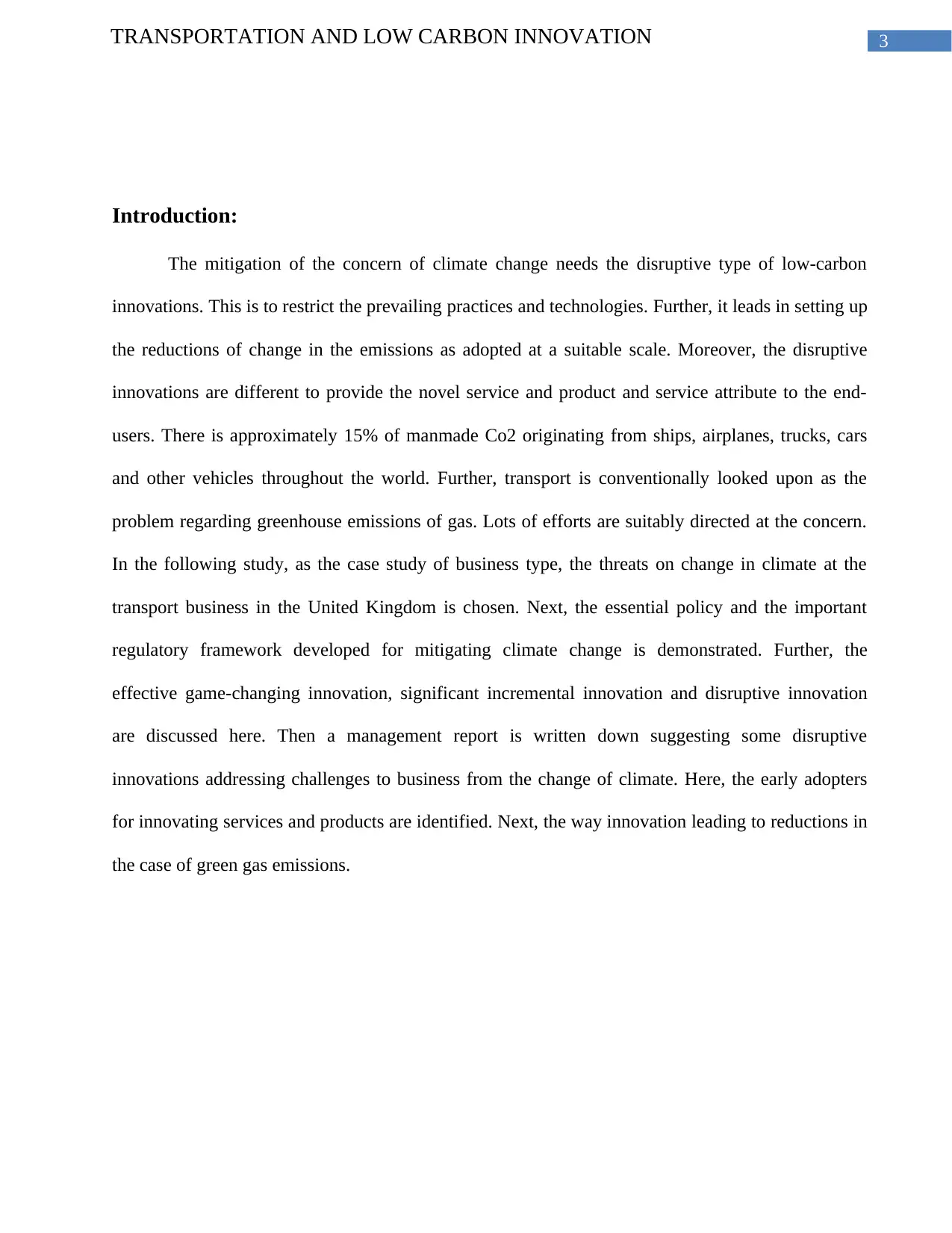
3TRANSPORTATION AND LOW CARBON INNOVATION
Introduction:
The mitigation of the concern of climate change needs the disruptive type of low-carbon
innovations. This is to restrict the prevailing practices and technologies. Further, it leads in setting up
the reductions of change in the emissions as adopted at a suitable scale. Moreover, the disruptive
innovations are different to provide the novel service and product and service attribute to the end-
users. There is approximately 15% of manmade Co2 originating from ships, airplanes, trucks, cars
and other vehicles throughout the world. Further, transport is conventionally looked upon as the
problem regarding greenhouse emissions of gas. Lots of efforts are suitably directed at the concern.
In the following study, as the case study of business type, the threats on change in climate at the
transport business in the United Kingdom is chosen. Next, the essential policy and the important
regulatory framework developed for mitigating climate change is demonstrated. Further, the
effective game-changing innovation, significant incremental innovation and disruptive innovation
are discussed here. Then a management report is written down suggesting some disruptive
innovations addressing challenges to business from the change of climate. Here, the early adopters
for innovating services and products are identified. Next, the way innovation leading to reductions in
the case of green gas emissions.
Introduction:
The mitigation of the concern of climate change needs the disruptive type of low-carbon
innovations. This is to restrict the prevailing practices and technologies. Further, it leads in setting up
the reductions of change in the emissions as adopted at a suitable scale. Moreover, the disruptive
innovations are different to provide the novel service and product and service attribute to the end-
users. There is approximately 15% of manmade Co2 originating from ships, airplanes, trucks, cars
and other vehicles throughout the world. Further, transport is conventionally looked upon as the
problem regarding greenhouse emissions of gas. Lots of efforts are suitably directed at the concern.
In the following study, as the case study of business type, the threats on change in climate at the
transport business in the United Kingdom is chosen. Next, the essential policy and the important
regulatory framework developed for mitigating climate change is demonstrated. Further, the
effective game-changing innovation, significant incremental innovation and disruptive innovation
are discussed here. Then a management report is written down suggesting some disruptive
innovations addressing challenges to business from the change of climate. Here, the early adopters
for innovating services and products are identified. Next, the way innovation leading to reductions in
the case of green gas emissions.
Paraphrase This Document
Need a fresh take? Get an instant paraphrase of this document with our AI Paraphraser
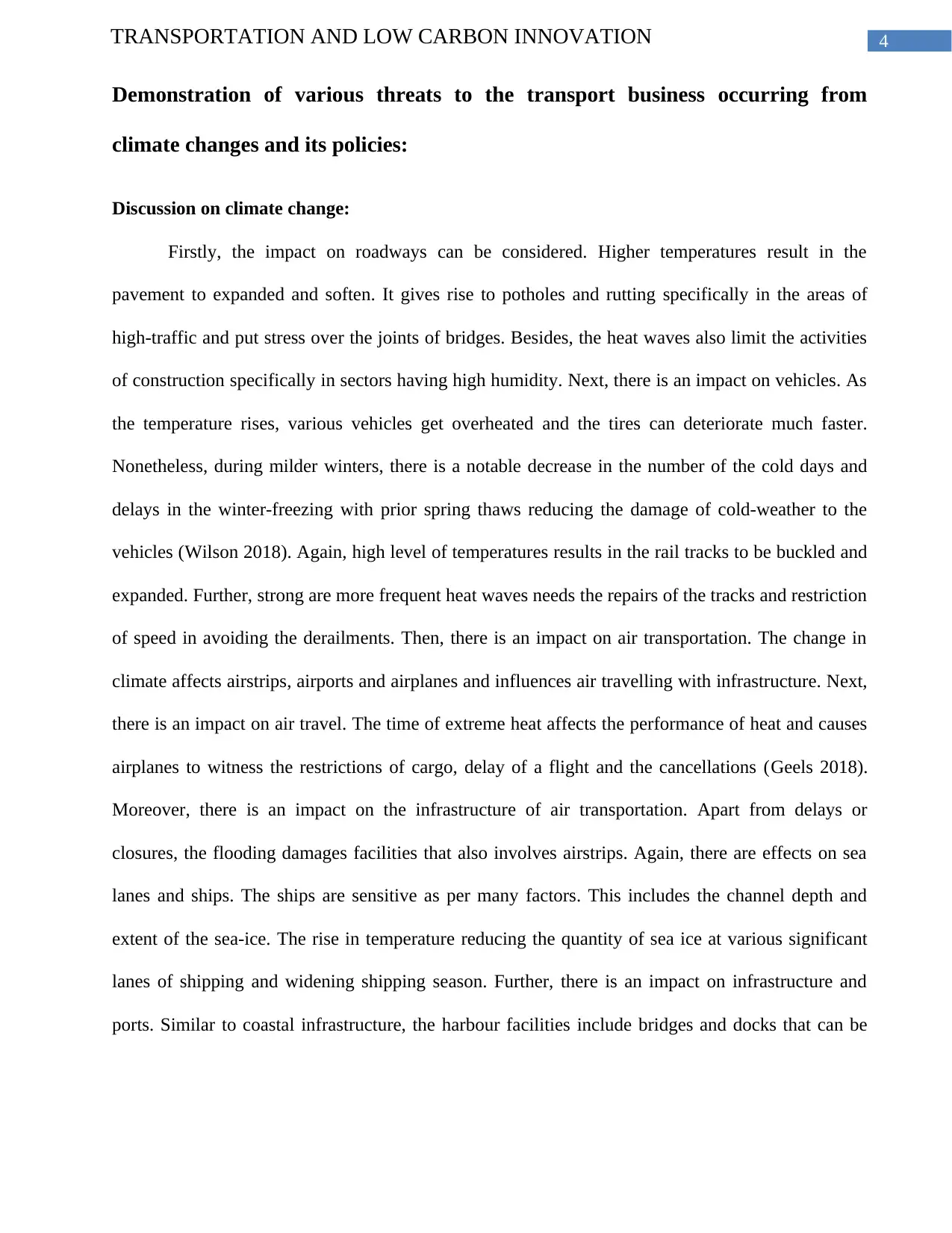
4TRANSPORTATION AND LOW CARBON INNOVATION
Demonstration of various threats to the transport business occurring from
climate changes and its policies:
Discussion on climate change:
Firstly, the impact on roadways can be considered. Higher temperatures result in the
pavement to expanded and soften. It gives rise to potholes and rutting specifically in the areas of
high-traffic and put stress over the joints of bridges. Besides, the heat waves also limit the activities
of construction specifically in sectors having high humidity. Next, there is an impact on vehicles. As
the temperature rises, various vehicles get overheated and the tires can deteriorate much faster.
Nonetheless, during milder winters, there is a notable decrease in the number of the cold days and
delays in the winter-freezing with prior spring thaws reducing the damage of cold-weather to the
vehicles (Wilson 2018). Again, high level of temperatures results in the rail tracks to be buckled and
expanded. Further, strong are more frequent heat waves needs the repairs of the tracks and restriction
of speed in avoiding the derailments. Then, there is an impact on air transportation. The change in
climate affects airstrips, airports and airplanes and influences air travelling with infrastructure. Next,
there is an impact on air travel. The time of extreme heat affects the performance of heat and causes
airplanes to witness the restrictions of cargo, delay of a flight and the cancellations (Geels 2018).
Moreover, there is an impact on the infrastructure of air transportation. Apart from delays or
closures, the flooding damages facilities that also involves airstrips. Again, there are effects on sea
lanes and ships. The ships are sensitive as per many factors. This includes the channel depth and
extent of the sea-ice. The rise in temperature reducing the quantity of sea ice at various significant
lanes of shipping and widening shipping season. Further, there is an impact on infrastructure and
ports. Similar to coastal infrastructure, the harbour facilities include bridges and docks that can be
Demonstration of various threats to the transport business occurring from
climate changes and its policies:
Discussion on climate change:
Firstly, the impact on roadways can be considered. Higher temperatures result in the
pavement to expanded and soften. It gives rise to potholes and rutting specifically in the areas of
high-traffic and put stress over the joints of bridges. Besides, the heat waves also limit the activities
of construction specifically in sectors having high humidity. Next, there is an impact on vehicles. As
the temperature rises, various vehicles get overheated and the tires can deteriorate much faster.
Nonetheless, during milder winters, there is a notable decrease in the number of the cold days and
delays in the winter-freezing with prior spring thaws reducing the damage of cold-weather to the
vehicles (Wilson 2018). Again, high level of temperatures results in the rail tracks to be buckled and
expanded. Further, strong are more frequent heat waves needs the repairs of the tracks and restriction
of speed in avoiding the derailments. Then, there is an impact on air transportation. The change in
climate affects airstrips, airports and airplanes and influences air travelling with infrastructure. Next,
there is an impact on air travel. The time of extreme heat affects the performance of heat and causes
airplanes to witness the restrictions of cargo, delay of a flight and the cancellations (Geels 2018).
Moreover, there is an impact on the infrastructure of air transportation. Apart from delays or
closures, the flooding damages facilities that also involves airstrips. Again, there are effects on sea
lanes and ships. The ships are sensitive as per many factors. This includes the channel depth and
extent of the sea-ice. The rise in temperature reducing the quantity of sea ice at various significant
lanes of shipping and widening shipping season. Further, there is an impact on infrastructure and
ports. Similar to coastal infrastructure, the harbour facilities include bridges and docks that can be
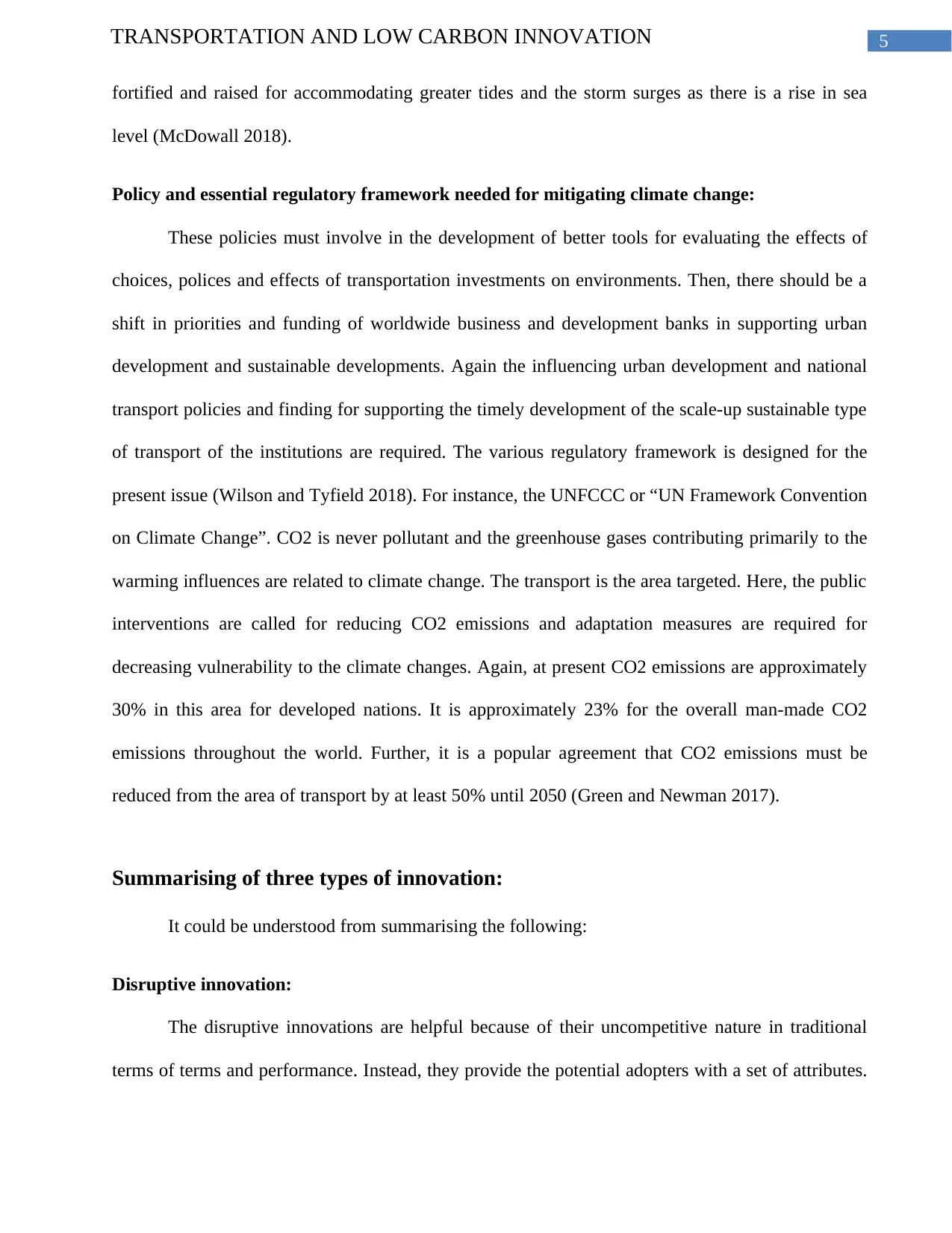
5TRANSPORTATION AND LOW CARBON INNOVATION
fortified and raised for accommodating greater tides and the storm surges as there is a rise in sea
level (McDowall 2018).
Policy and essential regulatory framework needed for mitigating climate change:
These policies must involve in the development of better tools for evaluating the effects of
choices, polices and effects of transportation investments on environments. Then, there should be a
shift in priorities and funding of worldwide business and development banks in supporting urban
development and sustainable developments. Again the influencing urban development and national
transport policies and finding for supporting the timely development of the scale-up sustainable type
of transport of the institutions are required. The various regulatory framework is designed for the
present issue (Wilson and Tyfield 2018). For instance, the UNFCCC or “UN Framework Convention
on Climate Change”. CO2 is never pollutant and the greenhouse gases contributing primarily to the
warming influences are related to climate change. The transport is the area targeted. Here, the public
interventions are called for reducing CO2 emissions and adaptation measures are required for
decreasing vulnerability to the climate changes. Again, at present CO2 emissions are approximately
30% in this area for developed nations. It is approximately 23% for the overall man-made CO2
emissions throughout the world. Further, it is a popular agreement that CO2 emissions must be
reduced from the area of transport by at least 50% until 2050 (Green and Newman 2017).
Summarising of three types of innovation:
It could be understood from summarising the following:
Disruptive innovation:
The disruptive innovations are helpful because of their uncompetitive nature in traditional
terms of terms and performance. Instead, they provide the potential adopters with a set of attributes.
fortified and raised for accommodating greater tides and the storm surges as there is a rise in sea
level (McDowall 2018).
Policy and essential regulatory framework needed for mitigating climate change:
These policies must involve in the development of better tools for evaluating the effects of
choices, polices and effects of transportation investments on environments. Then, there should be a
shift in priorities and funding of worldwide business and development banks in supporting urban
development and sustainable developments. Again the influencing urban development and national
transport policies and finding for supporting the timely development of the scale-up sustainable type
of transport of the institutions are required. The various regulatory framework is designed for the
present issue (Wilson and Tyfield 2018). For instance, the UNFCCC or “UN Framework Convention
on Climate Change”. CO2 is never pollutant and the greenhouse gases contributing primarily to the
warming influences are related to climate change. The transport is the area targeted. Here, the public
interventions are called for reducing CO2 emissions and adaptation measures are required for
decreasing vulnerability to the climate changes. Again, at present CO2 emissions are approximately
30% in this area for developed nations. It is approximately 23% for the overall man-made CO2
emissions throughout the world. Further, it is a popular agreement that CO2 emissions must be
reduced from the area of transport by at least 50% until 2050 (Green and Newman 2017).
Summarising of three types of innovation:
It could be understood from summarising the following:
Disruptive innovation:
The disruptive innovations are helpful because of their uncompetitive nature in traditional
terms of terms and performance. Instead, they provide the potential adopters with a set of attributes.
⊘ This is a preview!⊘
Do you want full access?
Subscribe today to unlock all pages.

Trusted by 1+ million students worldwide
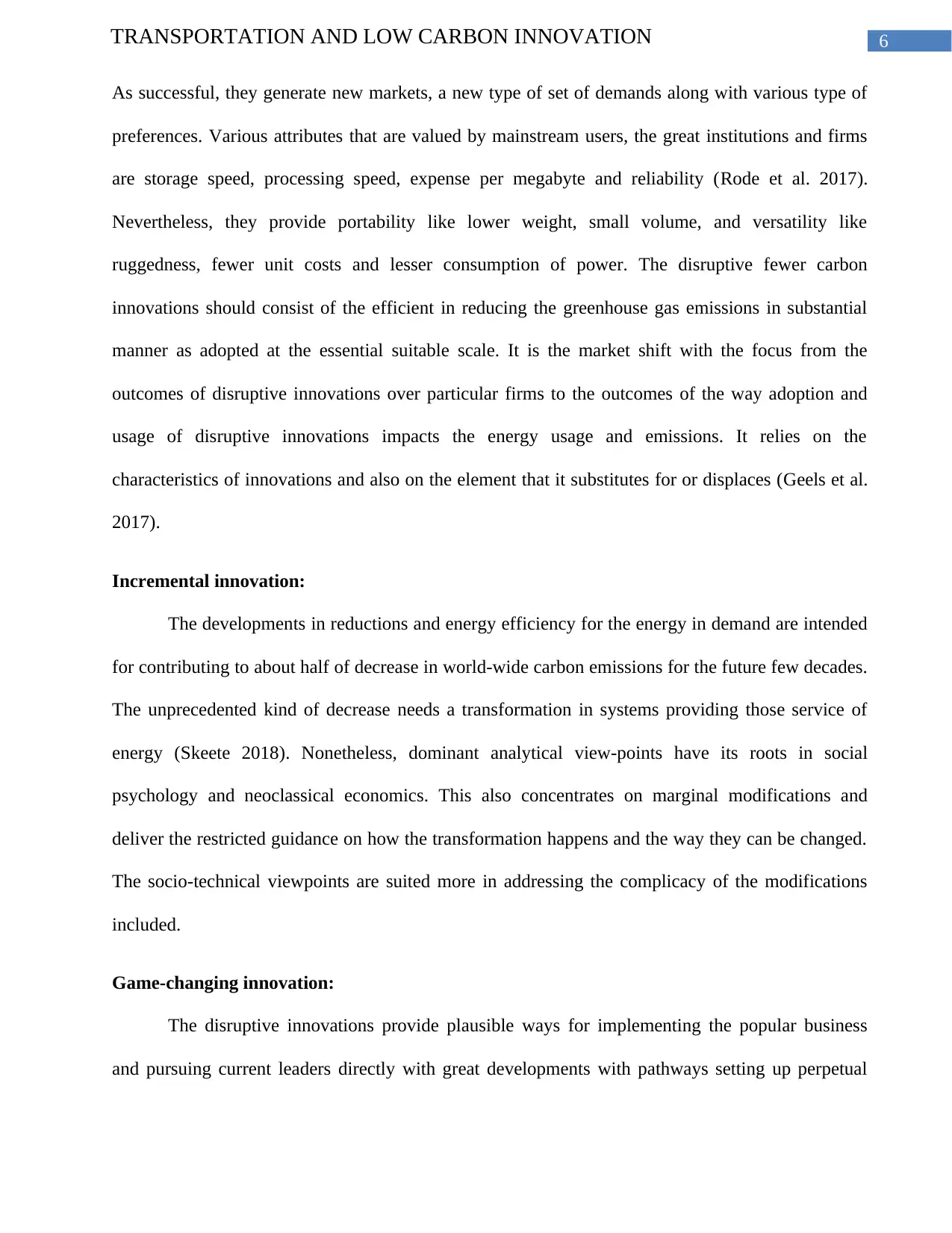
6TRANSPORTATION AND LOW CARBON INNOVATION
As successful, they generate new markets, a new type of set of demands along with various type of
preferences. Various attributes that are valued by mainstream users, the great institutions and firms
are storage speed, processing speed, expense per megabyte and reliability (Rode et al. 2017).
Nevertheless, they provide portability like lower weight, small volume, and versatility like
ruggedness, fewer unit costs and lesser consumption of power. The disruptive fewer carbon
innovations should consist of the efficient in reducing the greenhouse gas emissions in substantial
manner as adopted at the essential suitable scale. It is the market shift with the focus from the
outcomes of disruptive innovations over particular firms to the outcomes of the way adoption and
usage of disruptive innovations impacts the energy usage and emissions. It relies on the
characteristics of innovations and also on the element that it substitutes for or displaces (Geels et al.
2017).
Incremental innovation:
The developments in reductions and energy efficiency for the energy in demand are intended
for contributing to about half of decrease in world-wide carbon emissions for the future few decades.
The unprecedented kind of decrease needs a transformation in systems providing those service of
energy (Skeete 2018). Nonetheless, dominant analytical view-points have its roots in social
psychology and neoclassical economics. This also concentrates on marginal modifications and
deliver the restricted guidance on how the transformation happens and the way they can be changed.
The socio-technical viewpoints are suited more in addressing the complicacy of the modifications
included.
Game-changing innovation:
The disruptive innovations provide plausible ways for implementing the popular business
and pursuing current leaders directly with great developments with pathways setting up perpetual
As successful, they generate new markets, a new type of set of demands along with various type of
preferences. Various attributes that are valued by mainstream users, the great institutions and firms
are storage speed, processing speed, expense per megabyte and reliability (Rode et al. 2017).
Nevertheless, they provide portability like lower weight, small volume, and versatility like
ruggedness, fewer unit costs and lesser consumption of power. The disruptive fewer carbon
innovations should consist of the efficient in reducing the greenhouse gas emissions in substantial
manner as adopted at the essential suitable scale. It is the market shift with the focus from the
outcomes of disruptive innovations over particular firms to the outcomes of the way adoption and
usage of disruptive innovations impacts the energy usage and emissions. It relies on the
characteristics of innovations and also on the element that it substitutes for or displaces (Geels et al.
2017).
Incremental innovation:
The developments in reductions and energy efficiency for the energy in demand are intended
for contributing to about half of decrease in world-wide carbon emissions for the future few decades.
The unprecedented kind of decrease needs a transformation in systems providing those service of
energy (Skeete 2018). Nonetheless, dominant analytical view-points have its roots in social
psychology and neoclassical economics. This also concentrates on marginal modifications and
deliver the restricted guidance on how the transformation happens and the way they can be changed.
The socio-technical viewpoints are suited more in addressing the complicacy of the modifications
included.
Game-changing innovation:
The disruptive innovations provide plausible ways for implementing the popular business
and pursuing current leaders directly with great developments with pathways setting up perpetual
Paraphrase This Document
Need a fresh take? Get an instant paraphrase of this document with our AI Paraphraser
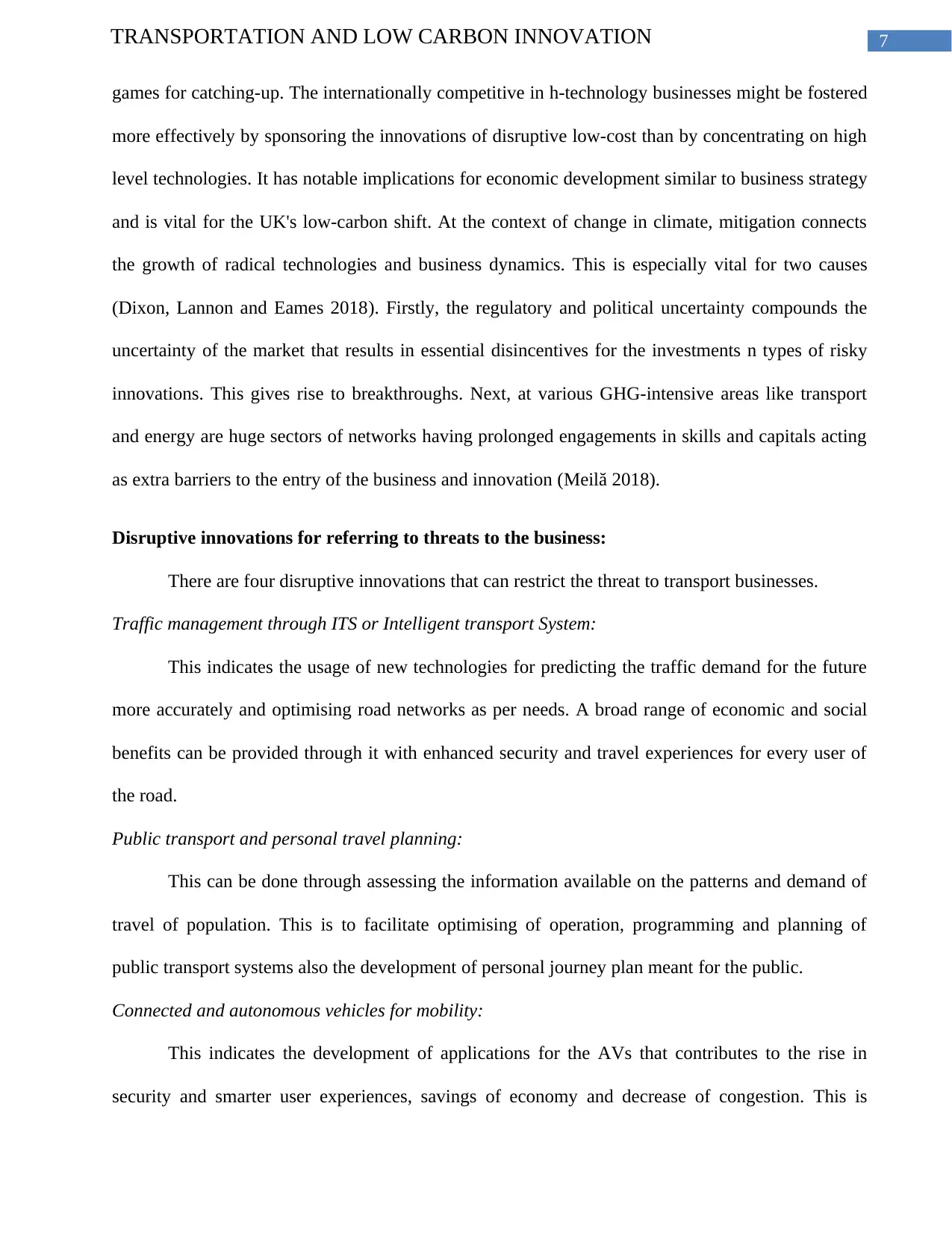
7TRANSPORTATION AND LOW CARBON INNOVATION
games for catching-up. The internationally competitive in h-technology businesses might be fostered
more effectively by sponsoring the innovations of disruptive low-cost than by concentrating on high
level technologies. It has notable implications for economic development similar to business strategy
and is vital for the UK's low-carbon shift. At the context of change in climate, mitigation connects
the growth of radical technologies and business dynamics. This is especially vital for two causes
(Dixon, Lannon and Eames 2018). Firstly, the regulatory and political uncertainty compounds the
uncertainty of the market that results in essential disincentives for the investments n types of risky
innovations. This gives rise to breakthroughs. Next, at various GHG-intensive areas like transport
and energy are huge sectors of networks having prolonged engagements in skills and capitals acting
as extra barriers to the entry of the business and innovation (Meilă 2018).
Disruptive innovations for referring to threats to the business:
There are four disruptive innovations that can restrict the threat to transport businesses.
Traffic management through ITS or Intelligent transport System:
This indicates the usage of new technologies for predicting the traffic demand for the future
more accurately and optimising road networks as per needs. A broad range of economic and social
benefits can be provided through it with enhanced security and travel experiences for every user of
the road.
Public transport and personal travel planning:
This can be done through assessing the information available on the patterns and demand of
travel of population. This is to facilitate optimising of operation, programming and planning of
public transport systems also the development of personal journey plan meant for the public.
Connected and autonomous vehicles for mobility:
This indicates the development of applications for the AVs that contributes to the rise in
security and smarter user experiences, savings of economy and decrease of congestion. This is
games for catching-up. The internationally competitive in h-technology businesses might be fostered
more effectively by sponsoring the innovations of disruptive low-cost than by concentrating on high
level technologies. It has notable implications for economic development similar to business strategy
and is vital for the UK's low-carbon shift. At the context of change in climate, mitigation connects
the growth of radical technologies and business dynamics. This is especially vital for two causes
(Dixon, Lannon and Eames 2018). Firstly, the regulatory and political uncertainty compounds the
uncertainty of the market that results in essential disincentives for the investments n types of risky
innovations. This gives rise to breakthroughs. Next, at various GHG-intensive areas like transport
and energy are huge sectors of networks having prolonged engagements in skills and capitals acting
as extra barriers to the entry of the business and innovation (Meilă 2018).
Disruptive innovations for referring to threats to the business:
There are four disruptive innovations that can restrict the threat to transport businesses.
Traffic management through ITS or Intelligent transport System:
This indicates the usage of new technologies for predicting the traffic demand for the future
more accurately and optimising road networks as per needs. A broad range of economic and social
benefits can be provided through it with enhanced security and travel experiences for every user of
the road.
Public transport and personal travel planning:
This can be done through assessing the information available on the patterns and demand of
travel of population. This is to facilitate optimising of operation, programming and planning of
public transport systems also the development of personal journey plan meant for the public.
Connected and autonomous vehicles for mobility:
This indicates the development of applications for the AVs that contributes to the rise in
security and smarter user experiences, savings of economy and decrease of congestion. This is
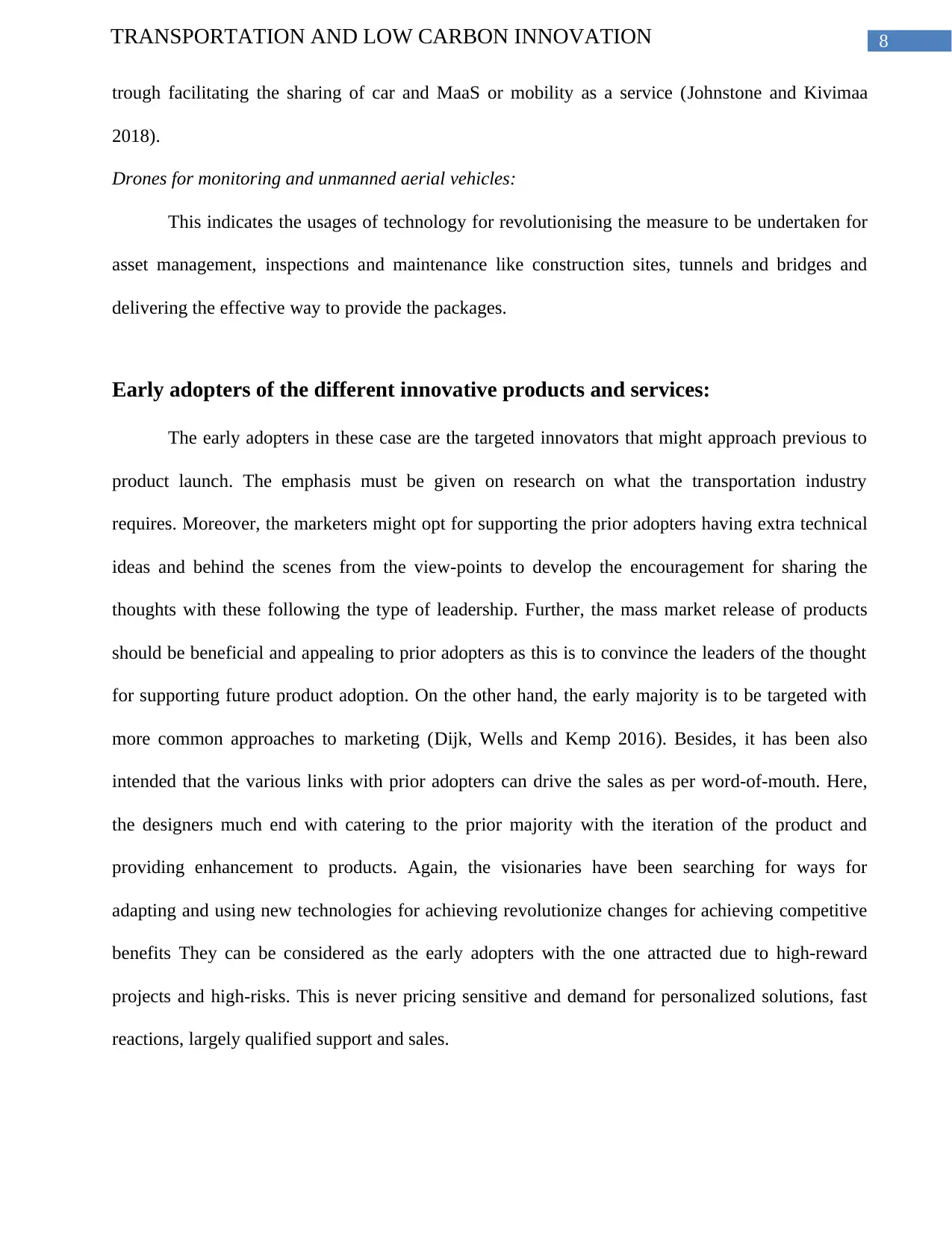
8TRANSPORTATION AND LOW CARBON INNOVATION
trough facilitating the sharing of car and MaaS or mobility as a service (Johnstone and Kivimaa
2018).
Drones for monitoring and unmanned aerial vehicles:
This indicates the usages of technology for revolutionising the measure to be undertaken for
asset management, inspections and maintenance like construction sites, tunnels and bridges and
delivering the effective way to provide the packages.
Early adopters of the different innovative products and services:
The early adopters in these case are the targeted innovators that might approach previous to
product launch. The emphasis must be given on research on what the transportation industry
requires. Moreover, the marketers might opt for supporting the prior adopters having extra technical
ideas and behind the scenes from the view-points to develop the encouragement for sharing the
thoughts with these following the type of leadership. Further, the mass market release of products
should be beneficial and appealing to prior adopters as this is to convince the leaders of the thought
for supporting future product adoption. On the other hand, the early majority is to be targeted with
more common approaches to marketing (Dijk, Wells and Kemp 2016). Besides, it has been also
intended that the various links with prior adopters can drive the sales as per word-of-mouth. Here,
the designers much end with catering to the prior majority with the iteration of the product and
providing enhancement to products. Again, the visionaries have been searching for ways for
adapting and using new technologies for achieving revolutionize changes for achieving competitive
benefits They can be considered as the early adopters with the one attracted due to high-reward
projects and high-risks. This is never pricing sensitive and demand for personalized solutions, fast
reactions, largely qualified support and sales.
trough facilitating the sharing of car and MaaS or mobility as a service (Johnstone and Kivimaa
2018).
Drones for monitoring and unmanned aerial vehicles:
This indicates the usages of technology for revolutionising the measure to be undertaken for
asset management, inspections and maintenance like construction sites, tunnels and bridges and
delivering the effective way to provide the packages.
Early adopters of the different innovative products and services:
The early adopters in these case are the targeted innovators that might approach previous to
product launch. The emphasis must be given on research on what the transportation industry
requires. Moreover, the marketers might opt for supporting the prior adopters having extra technical
ideas and behind the scenes from the view-points to develop the encouragement for sharing the
thoughts with these following the type of leadership. Further, the mass market release of products
should be beneficial and appealing to prior adopters as this is to convince the leaders of the thought
for supporting future product adoption. On the other hand, the early majority is to be targeted with
more common approaches to marketing (Dijk, Wells and Kemp 2016). Besides, it has been also
intended that the various links with prior adopters can drive the sales as per word-of-mouth. Here,
the designers much end with catering to the prior majority with the iteration of the product and
providing enhancement to products. Again, the visionaries have been searching for ways for
adapting and using new technologies for achieving revolutionize changes for achieving competitive
benefits They can be considered as the early adopters with the one attracted due to high-reward
projects and high-risks. This is never pricing sensitive and demand for personalized solutions, fast
reactions, largely qualified support and sales.
⊘ This is a preview!⊘
Do you want full access?
Subscribe today to unlock all pages.

Trusted by 1+ million students worldwide
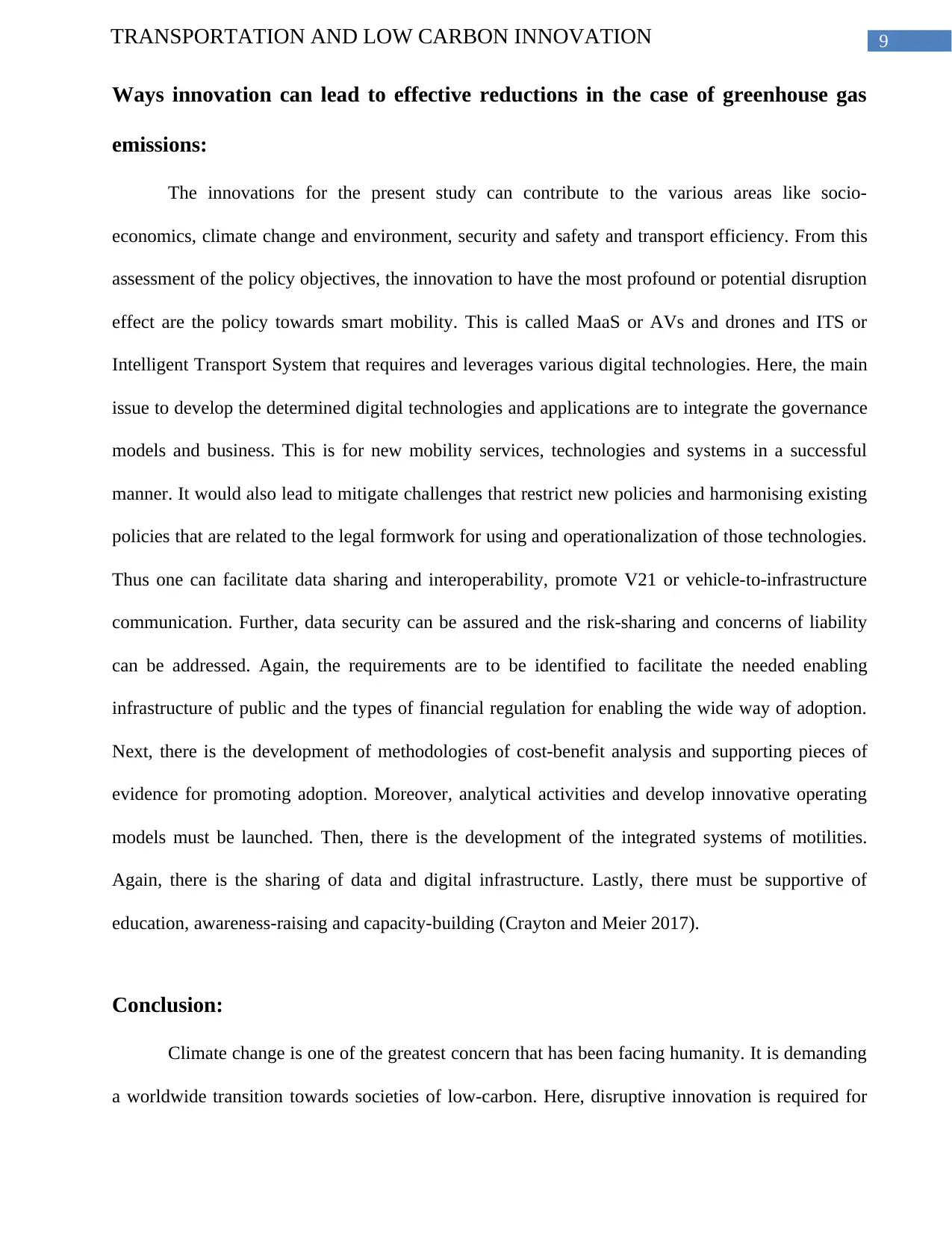
9TRANSPORTATION AND LOW CARBON INNOVATION
Ways innovation can lead to effective reductions in the case of greenhouse gas
emissions:
The innovations for the present study can contribute to the various areas like socio-
economics, climate change and environment, security and safety and transport efficiency. From this
assessment of the policy objectives, the innovation to have the most profound or potential disruption
effect are the policy towards smart mobility. This is called MaaS or AVs and drones and ITS or
Intelligent Transport System that requires and leverages various digital technologies. Here, the main
issue to develop the determined digital technologies and applications are to integrate the governance
models and business. This is for new mobility services, technologies and systems in a successful
manner. It would also lead to mitigate challenges that restrict new policies and harmonising existing
policies that are related to the legal formwork for using and operationalization of those technologies.
Thus one can facilitate data sharing and interoperability, promote V21 or vehicle-to-infrastructure
communication. Further, data security can be assured and the risk-sharing and concerns of liability
can be addressed. Again, the requirements are to be identified to facilitate the needed enabling
infrastructure of public and the types of financial regulation for enabling the wide way of adoption.
Next, there is the development of methodologies of cost-benefit analysis and supporting pieces of
evidence for promoting adoption. Moreover, analytical activities and develop innovative operating
models must be launched. Then, there is the development of the integrated systems of motilities.
Again, there is the sharing of data and digital infrastructure. Lastly, there must be supportive of
education, awareness-raising and capacity-building (Crayton and Meier 2017).
Conclusion:
Climate change is one of the greatest concern that has been facing humanity. It is demanding
a worldwide transition towards societies of low-carbon. Here, disruptive innovation is required for
Ways innovation can lead to effective reductions in the case of greenhouse gas
emissions:
The innovations for the present study can contribute to the various areas like socio-
economics, climate change and environment, security and safety and transport efficiency. From this
assessment of the policy objectives, the innovation to have the most profound or potential disruption
effect are the policy towards smart mobility. This is called MaaS or AVs and drones and ITS or
Intelligent Transport System that requires and leverages various digital technologies. Here, the main
issue to develop the determined digital technologies and applications are to integrate the governance
models and business. This is for new mobility services, technologies and systems in a successful
manner. It would also lead to mitigate challenges that restrict new policies and harmonising existing
policies that are related to the legal formwork for using and operationalization of those technologies.
Thus one can facilitate data sharing and interoperability, promote V21 or vehicle-to-infrastructure
communication. Further, data security can be assured and the risk-sharing and concerns of liability
can be addressed. Again, the requirements are to be identified to facilitate the needed enabling
infrastructure of public and the types of financial regulation for enabling the wide way of adoption.
Next, there is the development of methodologies of cost-benefit analysis and supporting pieces of
evidence for promoting adoption. Moreover, analytical activities and develop innovative operating
models must be launched. Then, there is the development of the integrated systems of motilities.
Again, there is the sharing of data and digital infrastructure. Lastly, there must be supportive of
education, awareness-raising and capacity-building (Crayton and Meier 2017).
Conclusion:
Climate change is one of the greatest concern that has been facing humanity. It is demanding
a worldwide transition towards societies of low-carbon. Here, disruptive innovation is required for
Paraphrase This Document
Need a fresh take? Get an instant paraphrase of this document with our AI Paraphraser
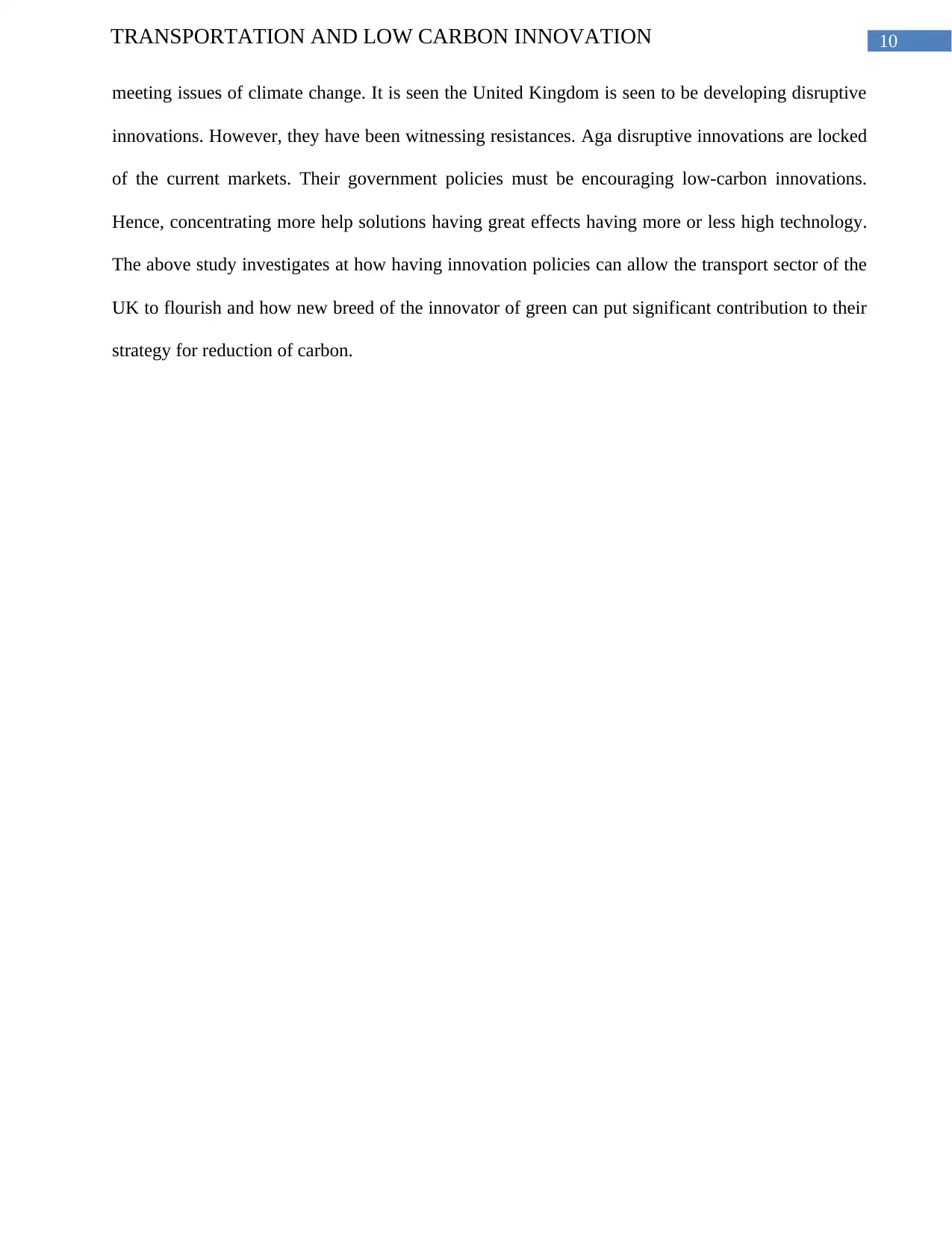
10TRANSPORTATION AND LOW CARBON INNOVATION
meeting issues of climate change. It is seen the United Kingdom is seen to be developing disruptive
innovations. However, they have been witnessing resistances. Aga disruptive innovations are locked
of the current markets. Their government policies must be encouraging low-carbon innovations.
Hence, concentrating more help solutions having great effects having more or less high technology.
The above study investigates at how having innovation policies can allow the transport sector of the
UK to flourish and how new breed of the innovator of green can put significant contribution to their
strategy for reduction of carbon.
meeting issues of climate change. It is seen the United Kingdom is seen to be developing disruptive
innovations. However, they have been witnessing resistances. Aga disruptive innovations are locked
of the current markets. Their government policies must be encouraging low-carbon innovations.
Hence, concentrating more help solutions having great effects having more or less high technology.
The above study investigates at how having innovation policies can allow the transport sector of the
UK to flourish and how new breed of the innovator of green can put significant contribution to their
strategy for reduction of carbon.
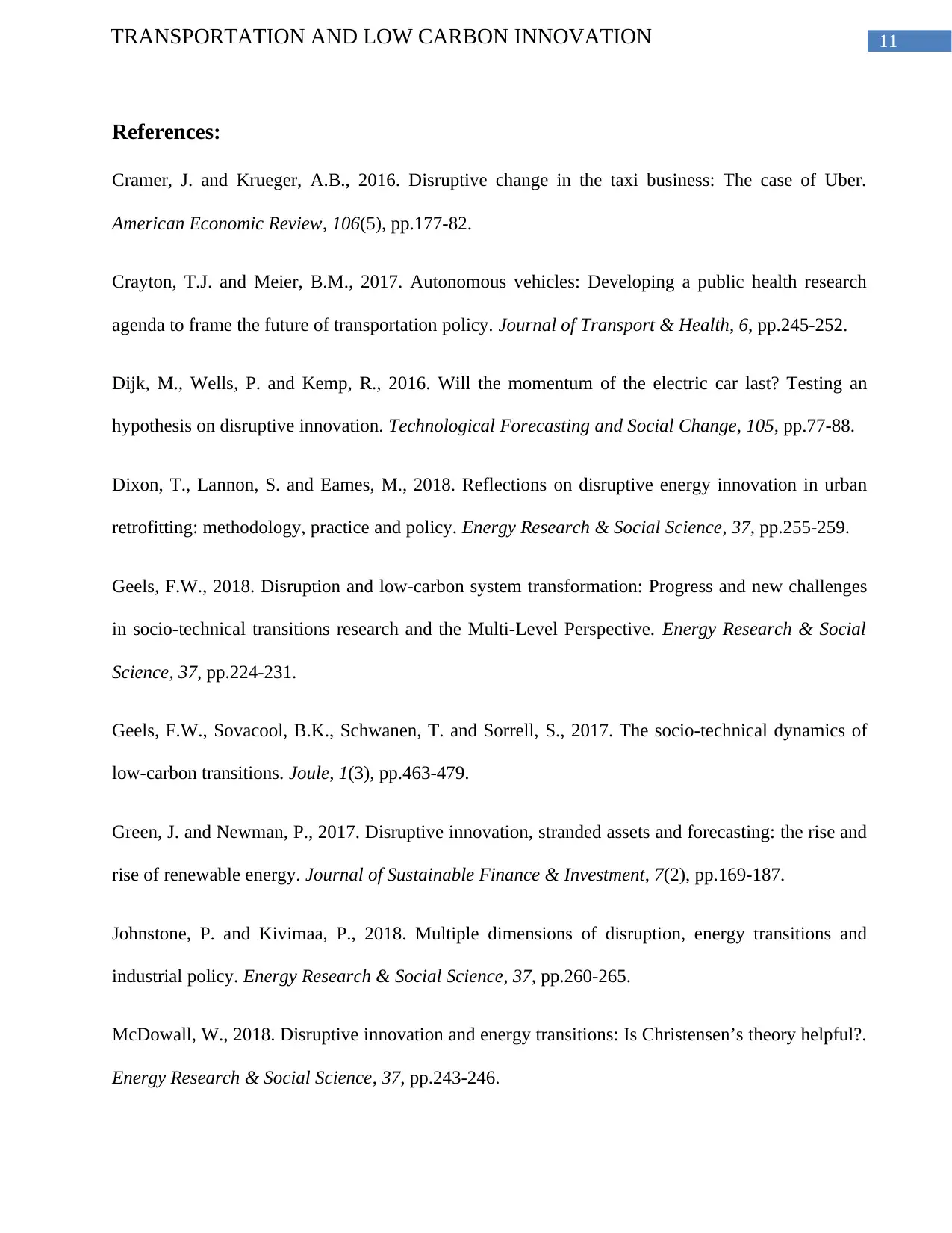
11TRANSPORTATION AND LOW CARBON INNOVATION
References:
Cramer, J. and Krueger, A.B., 2016. Disruptive change in the taxi business: The case of Uber.
American Economic Review, 106(5), pp.177-82.
Crayton, T.J. and Meier, B.M., 2017. Autonomous vehicles: Developing a public health research
agenda to frame the future of transportation policy. Journal of Transport & Health, 6, pp.245-252.
Dijk, M., Wells, P. and Kemp, R., 2016. Will the momentum of the electric car last? Testing an
hypothesis on disruptive innovation. Technological Forecasting and Social Change, 105, pp.77-88.
Dixon, T., Lannon, S. and Eames, M., 2018. Reflections on disruptive energy innovation in urban
retrofitting: methodology, practice and policy. Energy Research & Social Science, 37, pp.255-259.
Geels, F.W., 2018. Disruption and low-carbon system transformation: Progress and new challenges
in socio-technical transitions research and the Multi-Level Perspective. Energy Research & Social
Science, 37, pp.224-231.
Geels, F.W., Sovacool, B.K., Schwanen, T. and Sorrell, S., 2017. The socio-technical dynamics of
low-carbon transitions. Joule, 1(3), pp.463-479.
Green, J. and Newman, P., 2017. Disruptive innovation, stranded assets and forecasting: the rise and
rise of renewable energy. Journal of Sustainable Finance & Investment, 7(2), pp.169-187.
Johnstone, P. and Kivimaa, P., 2018. Multiple dimensions of disruption, energy transitions and
industrial policy. Energy Research & Social Science, 37, pp.260-265.
McDowall, W., 2018. Disruptive innovation and energy transitions: Is Christensen’s theory helpful?.
Energy Research & Social Science, 37, pp.243-246.
References:
Cramer, J. and Krueger, A.B., 2016. Disruptive change in the taxi business: The case of Uber.
American Economic Review, 106(5), pp.177-82.
Crayton, T.J. and Meier, B.M., 2017. Autonomous vehicles: Developing a public health research
agenda to frame the future of transportation policy. Journal of Transport & Health, 6, pp.245-252.
Dijk, M., Wells, P. and Kemp, R., 2016. Will the momentum of the electric car last? Testing an
hypothesis on disruptive innovation. Technological Forecasting and Social Change, 105, pp.77-88.
Dixon, T., Lannon, S. and Eames, M., 2018. Reflections on disruptive energy innovation in urban
retrofitting: methodology, practice and policy. Energy Research & Social Science, 37, pp.255-259.
Geels, F.W., 2018. Disruption and low-carbon system transformation: Progress and new challenges
in socio-technical transitions research and the Multi-Level Perspective. Energy Research & Social
Science, 37, pp.224-231.
Geels, F.W., Sovacool, B.K., Schwanen, T. and Sorrell, S., 2017. The socio-technical dynamics of
low-carbon transitions. Joule, 1(3), pp.463-479.
Green, J. and Newman, P., 2017. Disruptive innovation, stranded assets and forecasting: the rise and
rise of renewable energy. Journal of Sustainable Finance & Investment, 7(2), pp.169-187.
Johnstone, P. and Kivimaa, P., 2018. Multiple dimensions of disruption, energy transitions and
industrial policy. Energy Research & Social Science, 37, pp.260-265.
McDowall, W., 2018. Disruptive innovation and energy transitions: Is Christensen’s theory helpful?.
Energy Research & Social Science, 37, pp.243-246.
⊘ This is a preview!⊘
Do you want full access?
Subscribe today to unlock all pages.

Trusted by 1+ million students worldwide
1 out of 16
Related Documents
Your All-in-One AI-Powered Toolkit for Academic Success.
+13062052269
info@desklib.com
Available 24*7 on WhatsApp / Email
![[object Object]](/_next/static/media/star-bottom.7253800d.svg)
Unlock your academic potential
Copyright © 2020–2025 A2Z Services. All Rights Reserved. Developed and managed by ZUCOL.





